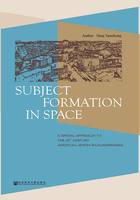
第3章 Synopsis
Bildungsroman, in a word, is the story of the characters' growing up and maturing in the mind and intelligence.Bildung, growing-up or formation, presents the common life experience of mankind with different initiation patterns for different gender, class, race and culture in different times and regions. As a special genre of the Bildungsroman, American-Jewish Bildungsroman shares the common ground with the classical Bildungsroman, distinctiveness with the ethnic Bildungsroman and modern characteristics with the American Bildungsroman. Jewish people are a race of spatial wanderers, and its frequent spatial movement endows the subject in literature with a strong sense of space and feeling of battered culture. This kind of spatialized subject with fragmented Jewish culture has to adjust himself to the norms of the frequently changing spaces and to disciplining himself to the dominant culture.
Growing-up is the process of the individual growing into the subject in time and space.The basic proposition of bildung in light of Lefebvre's theory of "the production of space" is that man grows up in the space, and meanwhile produces the space of growing-up. The spatial subject is different from the autobiographic and coherent temporal subject. It is a mobile, changeable and inconsistent subject in the conflict and combination of space and memory, and interweaves the more complex concepts of time from the aspects of society and culture. Spatiality of the body premises the spatial subject. The interrelation between the body and the space contains not only the phenomenological relations, that is, man with normal organs stretches his bodily posture in the abstract space without social conditions, but also the impact of spatial conditions ruled by social orders on the bodily behavior patterns and the reflection of the body to the changeable social conditions. Such a body expresses the subject's inner desire as well as mirrors the real outer spatial conditions. In this sense, spatial subject is the production of the complicated social relations through bodily social activities. Textually, the spatial practice of the Jewish protagonists from the individual to the subject in the 20thCentury American-Jewish Bildungsroman resides in the relationships between the spatial principles and the gender, race and self-formation subjects.
For the Jewish protagonists, the spatial shift, on the one hand, means to escape from the Old Europe and intrude into the New America, and on the other hand, from Jewish family and into the urban space. The spatial transformation and conflict between the "feminized" Jewish ghetto in the Old Europe and the "heroized" space in America result in the protagonists' escape from the traditional Jewish family. Sexual subject is often heralded through the sexual performance of masculinity in the process of subject formation in the heterotopic space. Sexual subject, as the beginning of the protagonists' growing up of along with assimilation, is often interwoven with the racial subject, who demonstrates that, with the stretching of the subject's spatial activities, the growing subject does his utmost to pass him off as a "white" into the American "white" space to break the boundary of identity marks. The process of formation of the sexual and racial subject is also one of the private space being nibbled by the social space. Only when the spatial anxiety of being nibbled is self-justified and self-released can the individual grow up into the subject. The newly formed subject is unstable, which embodies the uncertainty of the Jewish identity in American society and the fragmentation and incoherence of the modern space.
The process of the spatial production of the subject demonstrates Lefebvre's triadic process of "spatial practice," "representations of space," and "representational spaces," which forms the spatial logic of subject formation. "Spatial practice," in Lefebvre's term, as the process of producing the material form of social spatiality, is thus presented as both medium and outcome of human activity, behavior, and experience (Soja), which, in the 20thCentury American-Jewish Bildungsroman, is embodied by "spatial behavior logic of escape and intrusion." The "real" space in the novel, which is the artistic representation of the realistic space, forms the "representations of space," which, in the 20thCentury American-Jewish Bildungsroman, mainly include the ghetto, the Jewish family or school, and the urban space, which metaphorize or symbolize the "representational spaces." Ghetto, as the open and exclusive space of heterotopia, constructs such marginal spaces as race, gender or sex, etc. The ethics evolved from Jewish religion and complied by in the Jewish family or schools yoke spatially the subject on the road of the subject's growing up. With the expansion of the space for the subject's growing up, the disciplining discourses between the spaces of the family and the mainstream society call for the re-direction of the subject's bildung and stipulate the formation of the subject. The urban space provides the subject with the comparatively free and open space, which is the representation of carnival space for the subject's bodily free performance, the extent to which the urban space is not the background for the subject's activities, but participates in the subject's growing-up.
The American-Jewish Bildungsroman explains, to a degree, the dialectic relationships between ethnicity,bildung and space. The universality and specialty of the Jewish individual growing into the subject gives the complicatedness, uniqueness and multifariousness to the bildung of American minorities in the multi-cultural space of America.